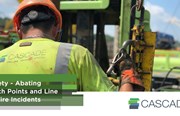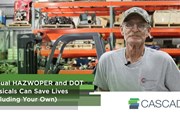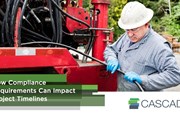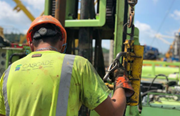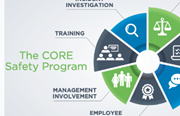Job Site Safety is in Your Hands
By: Dale DuscherAccording to the US Department of Commerce, “striking against” and “caught between” are two of the leading causes of disabling accidents, and the majority of these are hand related. Cascade integrated the Show Your Hands policy into our CORE™ safety program, to incorporate a robust pre-loss evaluation, while increasing awareness, developing strong communication and ultimately, prevent hand injuries in the workplace. Our Show Your Hands policy helps to prevent these types of injuries from happening by putting extra focus on tool inspection, cuts and punctures, line of fire, pinch points, moving parts, and manual material handling.
Let’s look at a few key points to focus when considering hand safety on your projects:
Inspect tools
All tools should be inspected for deficiencies before any task or work begins. All faulty tools should be removed from service or tagged “out of service” until they have been repaired or replaced.
Also, be sure to use the correct tool for the job and discard any worn-out tools. There should be clear and consistent communication with each team member regarding any deficiencies, both during and after the tooling/equipment inspection.
Cuts and punctures
Always wear task appropriate gloves and inspect all tooling for slivers and burrs before placing your hands on it.
Often, these hazards go unnoticed until a sliver becomes lodged in your hands or legs. One example of where this hazard exists are the breakout wrenches on sonic rigs. These apply tremendous force to the tool joint while loosening tool joints. However, when the rods are tight, or the wrench jaws are worn, they tend to slip, causing large metal burrs and slivers on the tool joints. Even manual use of a pipe wrench can cause slivers when used on steel pipe.

Burrs can also be found on drill casing. Be sure to inspect for sharp edges & damage.
Line of Fire
Always keep hands and body parts out of the line of fire.
Use caution when handling augers, drills, casing, and anytime you use your hands. Additionally, you should always make you have a clear line of sight, constant communication with your team members & that your work area is free of recognizable “line of fire” hazards. Drilling sites have several lines of fire hazards & injuries can occur when a person puts their hands or other body parts in a line of fire. Thorough pre-shift inspections will help to identify these hazards, along with a good discussion in the tailgate safety meeting. Keep in mind that something may not be a line of fire hazard until it fails. One example is a hose under pressure. If it fails, it can create a high-pressure pin-hole that can puncture the skin. Another tool we use at Cascade for hazard identification is the Job Safety Analysis (JSA). These are reviewed and understood before any work starts, especially if the task deviates from the original scope of work, or there are site-specific hazards. Whatever tool you use, be sure you have a good protocol for verbal communication or eye contact when two or more employees are working together.
Pinch Points
Identify and label all pinch points and keep hands away from moving parts and watch out for your coworkers.
All pinch points and potential pinch points must be identified and labeled. While looking for potential pinch points, keep in mind that some of these are hidden until the rig or machine is manipulated into a different position. For example: raising or lowering the arms of a skid steer will create new hazards and pinch points. Loose drill rods or pipes can be one the biggest causes of pinch point injuries. Hazardous pinch points can occur if the drill rod is stacked incorrectly, not properly fastened down, or someone attempts to move without mechanical advantage. Also, watch out for the safety of your coworkers and ensure they are aware of any pinch points. Simply “showing your hands” and establishing eye contact, along with verbal communication with your fellow coworker, while working around potential pinch points, can be the key to avoiding a serious injury.
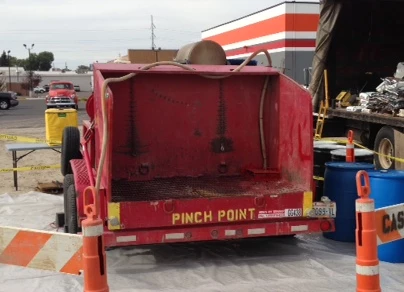
“Pinch Point” labeled on decontamination trailer to prevent workers from pinching body parts.
Moving Parts
Guard all gears, chains, flywheels, and other moving parts and ensure all parts are clear during operation.
All chains, gears, and flywheels should always be guarded to prevent hands or clothing from becoming caught in them. This includes all belts and fan blades, or any moving shaft, such as the shaft on a Moyno pump, the rotation of a spinning auger, or the fan blades in on a vehicle radiator. Conducting routine maintenance and evaluating any task involving moving parts or stored energy prior to performing the task will ensure all risk is mitigated. Personnel should never work on equipment, while it is running, or during operation. Be sure to review and incorporate the strict guidelines from OSHA regarding the LOTO (lock out tag out) procedure to ensure compliance with OSHA standards. Remember – communication is key so ensure that all moving parts are clearly discussed with team members working on near, or around that piece of equipment prior to use.
Manual Handling
Use mechanical advantage or get assistance from a coworker. Always wear the right gloves for the job. Chock all pipe, augers or any other item that can roll.
Manual handling involves the use of our hands; therefore, we must be aware of all hazards that are associated with any using our hands. Repetition of tasks gives a higher level of confidence and can impact the “awareness” of the associated manual handling hazards. Be sure your team maintains a constant state of awareness for every manual handling hazard and use the available mechanical advantage. Employees should always take the opportunity to give their hands a break and use the correct tools provided to you. Ultimately, during a pre-job risk assessment, if the task is deemed unsafe, or a recognizable hazard is identified, initiate STOP WORK so the task can be re-evaluated to ensure it is safe for the your team to perform.


A wheelbarrow or skid steer can be used as a mechanical advantage to protect workers.
Hand safety and the prevention of hand injuries is a top priority and an ongoing effort at Cascade. Our Show Your Hands policy was designed to prevent hand and finger injuries.
Another way we bring attention to hand safety is by running safety driven initiatives, or Safety Campaigns. With the goal of reducing and preventing all hand injuries, we will be gearing our next campaign towards hand safety. The “Show Your Hands 4th Quarter Focus” campaign looks at hand safety from a pre-loss and proactive viewpoint and was developed using data gained from our incident reporting system. This campaign will work by designating opportunities that a manager will have to observe their employees demonstrating positive use of Show Your Hands. The goal is that by focusing on a specific positive behavior, it will allow them to spot the negative behaviors as well. This campaign will not only increase management involvement, it will refresh our Show Your Hands policy and reward employees that are working hard to prevent hand injuries. Those employees that are “caught” displaying positive behaviors, not only showcase their skill as a positive and proactive risk assessor but will also be awarded a Cascade “Show Your Hands” Challenge Coin. This campaign will run through Q4 2019.
The Show Your Hands Challenge Coin
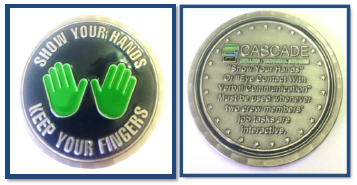
EHS would like to thank every employee for their continued commitment to hand safety, the “Show Your Hands” policy & the Cascade CORE™ safety program.


